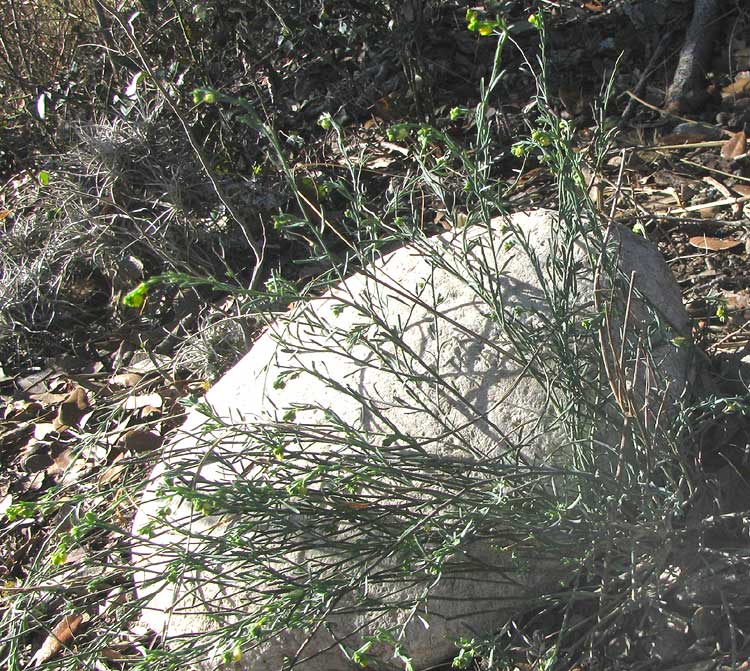Excerpts from Jim Conrad's
Naturalist Newsletter

from the January 20, 2013 Newsletter issued from the valley of the Dry Frio River in northern Uvalde County, southwestern Texas, on the southern border of the Edwards Plateau; elevation ~1750m (~5750 ft); N29.62°, W99.86°; USA
RUE OF THE MOUNTAINS FLOWERING
Yet a second wildflower blossoming here in mid January is the wiry, woody-based, foot-tall shrub with tiny yellow blossoms at some of its branch tips shown above. A close-up of one of its emerging flower clusters, or inflorescences, showing the stem, leaves calyx and corolla all dotted with glands appears below:

A broken-open blossom with one side of the 1/8th inch long (3mm), yellow corolla removed and showing that even the ovary is glandular is seen below:

With my foggy vision, in the field I couldn't see the flowers and figured that this plant was something like the yellow-flowered, stiff-branched Scotch Broom we met in Oregon, a member of the Bean Family. However, the moment the above flower pictures came onto the screen it was clear that there's nothing beanlike to this plant. Few plant families can be so glandular. The foliage was strongly aromatic, too. Immediately the Citrus Family, the Rutaceae, came to mind, the family of oranges and grapefruits, but also of some interesting and often medicinal native plants.
Guessing that it was a member of the Citrus Family, on the Internet it was easy enough to figure out that what we have is THAMNOSMA TEXANA, truly a member of the Citrus Family. In this area most people seem to call it Dutchman's Breeches because of the shape of its fruits, but in eastern North America a famous spring wildflower already is known by that name. Our plant also goes by the names Blisterweed, Texas Desert-Rue, and Rue of the Mountains. The name Texas Desert-Rue ignores the fact that the plant also occurs in arid northern Mexico and other southwestern desert states as far north as Colorado, so here we'll go with Rue of the Mountains. It is described as growing mainly in thin soil atop limestone, which is exactly where our plant occurred, on a limestone outcrop beside the Dry Frio River.
In Mexico we've often run into the "real Rue," which is an important medicinal herb, as described at http://www.backyardnature.net/mexnat/rue.htm.
On that page also you can see that "real Rue" produces small, yellow flowers and is heavily invested with glands filled with fragrant oils, just like our Rue of the Mountains.
Rue of the Mountains contains a toxic compound known as furocoumarin, which induces the interesting medical condition known as photosensitization. Humans avoid the plant, but a study of sheep who ate dried Rue of the Mountains reported increased body temperature in the sheep, avoidance of light (photophobia), swelling caused by fluid accumulation (edema) of the muzzle, ears, and vulva, a general dermatitis, and an eye problem called keratoconjunctivitis. These symptoms suggest why a plant would evolve containing phototoxic compounds: To make it unpleasant for animals to eat it!